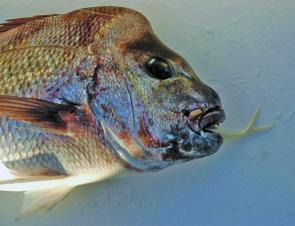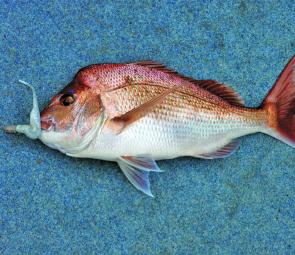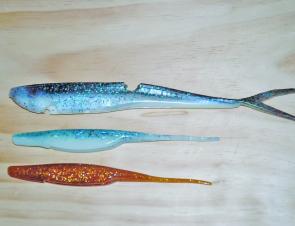In the past I have covered a wide variety of topwater, shallow and mid-depth soft plastic fishing techniques for blue water species from tuna to snapper. In this article, I will look at deep water tactics for chasing snapper on soft plastics around the wide reef fishing grounds.
The main difference of fishing snapper deepwater, compared to shallower reef areas like Hutchies to cape Moreton, is using heavier jigheads. As a rough rule of thumb I’ll use a 1/2oz wt jighead for drift fishing in 50m of water and 1 1/2oz in 90m of water.
The soft plastic also gets a little larger; up to 10” lures, either fork-tailed or straight-tailed fish/shad profiles come into their own.
A very experienced South East Queensland deep water soft plastics fishermen is Brisbane Sportfish Club stalwart and past-president Roy Lane. Roy uses jigheads from 3/4oz to 2oz fishing water 50-100m. The better the conditions, that is the less the current and the less the wind effect, then the lighter the jighead.
Like a lot of anglers who fish this deep technique, Roy quite often travels out wide from the South Passage Bar. Locations such as the 33’s, Square Patch, Round Patch and Deep Tempest are just some of the names of hot locations that spring to mind.
Snapper can be caught all year, conditions permitting, with May to November normally being the better months on the deepwater grounds. Winter and early spring have the best weather; light breezes and predicable patterns. And this time of year typically offers lesser current run, which means you have more chance of getting your lures down into the strike zone.
Most of the target fish in the 50-100m depths are in the zone from 10m off the bottom around structure, like wire weed. However, in Roy’s experience, on rare occasions you may find bait schools balled up at mid water depths of around 20-40m. And these bait balls can turn on some serious action!
When approaching a bait ball, Roy’s recommended technique is to just lower your soft plastic lure to the depth of the bait and expect a strike. The usual approach is to free spool the lure over the side and into the depths, or you can do a short cast with the soft plastic offering away from boat.
Roy points out that once the lure is in the strike zone, it only takes supple movements of the lure to attract a strike. Use your sounder to find the strike zone, which will be where the fish are!
Roy’s sounder is set to the split screen sonar mode; one side is set to zoom the bottom 15m of the water column and the other side shows the full-depth, covering from the surface to the seafloor, to keep an eye out for the mid-water schools of balled bait.
Roy uses 7'' soft plastics and he is not fussy on colour; except he does prefer lure’s that have a bit of white. I’m still partial to darker colours, such as calamari/squid representations, but my Dad prefers to uses some of the baitfish Glo colours, which are custom made for the Australia only market.
I have tried stocks of both scented and unscented lures in deepwater fisheries and both have worked at some time or another.
When discussing which is best you’ll hear or read something like, “I caught three fish in a row on that lure and started using it forever”. This approach fails the mathematical analysis test. After many years and many fishing trips, I have given scented and unscented lures equal water time (side by side quite often) and the statistics show that there is not much between them when reef fishing. There have been times when the unscented lures have had a run of ten snapper in a row for an average weight of 12lb per fish. Then the pendulum swings back the other way…
Truly accurate tests have to be run across hundreds of captures across many years in a variety of conditions. At the end of the day, it is very difficult to actually prove if one is better than the other. Both options will have their day.
Nevertheless, having said all that I’ll start with whatever worked last time, and this applies to colour as well. After giving a colour a run I’ll switch and change across a variety of fish patterns; calamari browns, pinks, whites, glows and dark watermelons. Across a normal day I’ll use a variety of colours and a variety of scented and unscented options to ensure I’m covering all my options.
When fishing deep water techniques you’ll catch more species than just snapper. In South East Queensland the reef fish that vies closest to snapper for bragging rights is the pearl perch.
Bouncing your heavy jigheaded soft plastic lure on the bottom, or even dragging your lure onthe bottom, out wide over productive ground is a great way to score yourself a feed of prime tasting bucket mouthed pearl perch. And with a five fish bag limit for snapper, you may need alternative targets when you bag out.
Next month I’ll cover the tackle and equipment set ups for deepwater soft plastics and the bigger tougher fighting fish that you’ll often encounter.
Reads: 8265
A 10” Lunker City soft plastic tail hanging out of a snapper’s mouth.

A snapper taken in deep water on a large jighead and a crystal shad 7” Assassin.

Roy Lane with a soft plastic caught snapper from the deep reefs wide of South Passage Bar.

Profiling: A 10” Lunker City Fin-S Shad above two 7” Assassin straight tail shads (the middle lure in glo pilly colour and the lower lure in scented calamari colour. This selection of three lures offer; scent, glow in the dark and big profile options.




